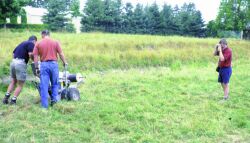
If you thought underground electronic fencing was just for pets, think again. Gerald Siroen, Ilderton, Ont., is in the midst of an experiment to see if it can be used for cattle.
The invisible type fence uses an underground wire that uses radio signals to activate shock collars worn by animals that are fenced in. Since cattle can be trained to stay inside a single strand of electrified fence wire, Siroen theorized that they should also be able to learn to respect a fence they can't see.
His goal was to fence cattle out of a creek that runs through his property to help prevent stream bank erosion.
When Siroen learned there might be grant money available for soil and water conservation projects through a group called the Upper Thames River Conservation Authority, he approached the group's water quality specialist, Craig Merkley.
Merkley visited Siroen's farm and decided the underground fence idea had merit. The two contacted Richard Martin, who owns Hidden Fence, London, Ontario, and sells Pet Safe underground fencing. In no time at all the project was underway.
It took 6,000 ft. of cable to fence the area where Siroen wanted to discourage his 20 or so cows and their calves from going. They started with their regular cable, but because they needed so much more than usual, they had trouble with it breaking and had to start over with heavier cable, Siroen says.
The regular power supply for the buried fence cable wasn't able to supply an even flow of electricity all the way around, so they had to find a larger one.
With the fence hooked into the main household power supply, the possibility of a lightning strike became a concern and a lightning arrester had to be installed. The house is only about 60 ft. from the buried cable, so if there was a strike in the area, we figured the cable would carry it into the house, he says.
While the cable is buried and the hidden fence can be turned on, another problem was collars big enough to fit cattle. Pet Safe agreed to provide special collars.
The Pet Safe system works with three signals. The first is visual, which amounts to white plastic flags spaced at intervals around the perimeter in the fenced-in area. The second is audible. The collar emits a sound when the animal wearing it approaches buried cable. And finally there's a shock to drive home the fact that the fence is there.
All three of these will be used when the time comes for Siroen to train his cattle. While everyone involved sees promise in this fencing system, it's still not proven. Siroen is confident it will work and has already thought about expanding it to other areas. He's also given some thought to gates. I like the idea that we'll be able to enter the pasture anywhere we want with a tractor, but I have to be able to move the cows out as well. We'll have to develop a gate area where the cattle don't receive the audible and shock signals, so they'll be easy to move out of the pasture when need to, Siroen says. He expects to have the system fully functional by next spring.
